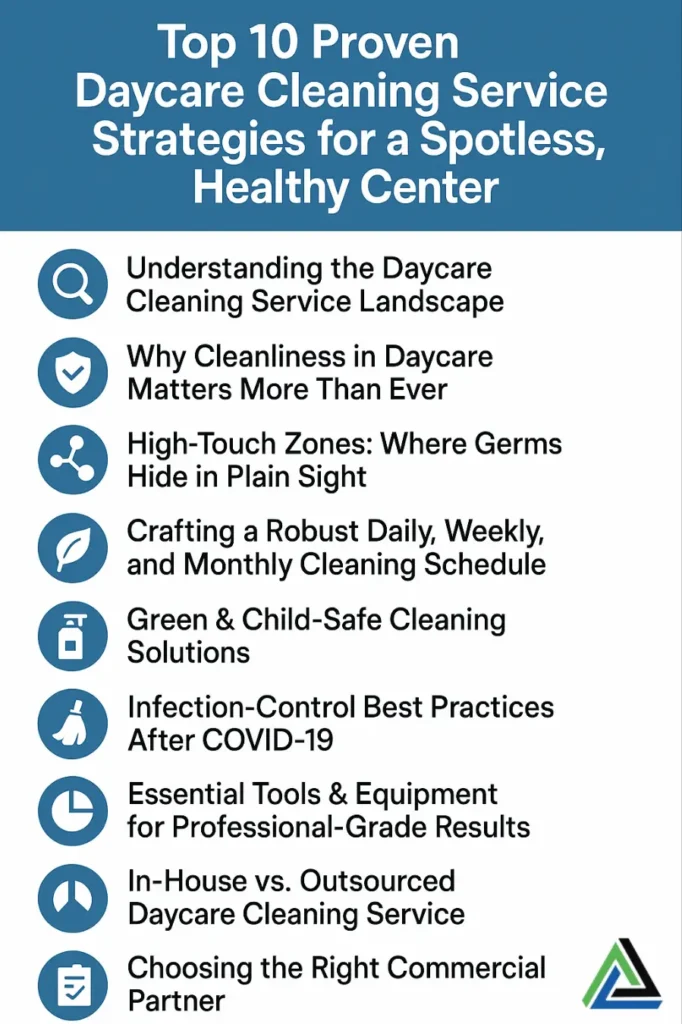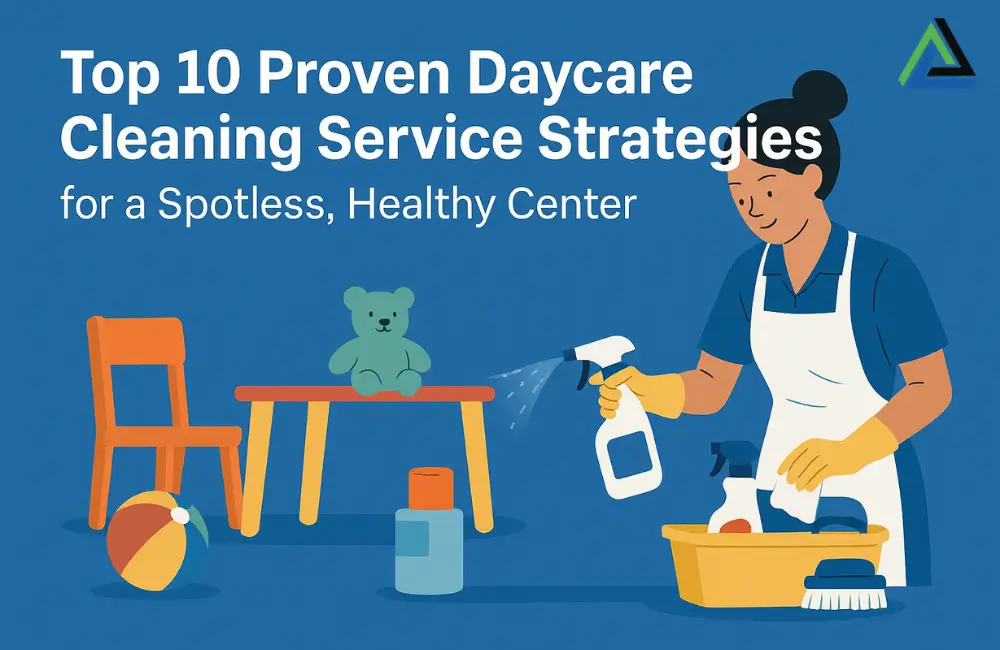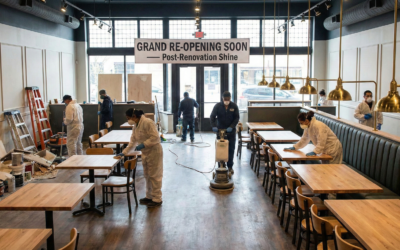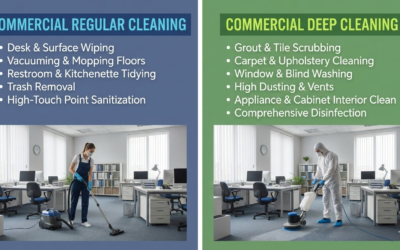1. Understanding the Daycare Cleaning Service Landscape
Running a childcare center is about more than story time and snacks; it’s about creating a safe, hygienic environment where little explorers thrive. A daycare cleaning service must tackle unique challenges—toddlers put everything in their mouths, spills happen every hour, and state inspectors can arrive unannounced. Unlike residential cleaning, where aesthetics dominate, childcare sanitation centers on health protection and compliance.
Key Points to note :
- Health & safety first: Sanitation in childcare centers is driven by infection-control, not just surface shine.
- High-risk behaviours: Toddlers mouth toys and touch everything, so cleaning must target germs on toys, floors, and high-touch surfaces.
- Non-stop messes: Spills, crumbs, and bodily fluids appear hourly, demanding frequent, rapid clean-ups.
- Regulatory pressure: State and health inspectors can show up without warning; protocols must meet strict childcare hygiene standards.
- Specialised approach: Child-safe, low-toxicity disinfectants and detailed checklists differentiate daycare cleaning from typical residential services.
1.1 Key Differences Between Residential & Childcare Cleaning
Childcare spaces demand hospital-grade disinfection on pint-sized furniture. Regulators require written logs, labeled chemicals, and safe storage out of children’s reach. Residential crews seldom sanitize toys every day; daycare cleaners must.
1.2 Core Goals: Safety, Health, and Reputation
A spotless classroom lowers absenteeism, boosts enrollment, and reassures parents. In competitive markets, “clean” is the new marketing edge—centers boasting third-party-certified cleaning attract trust quickly.
2. Why Cleanliness in Daycare Matters More Than Ever
2.1 Impact on Child Health & Development
Children’s immune systems are still training. According to the Centers for Disease Control and Prevention, proper cleaning and disinfection can cut gastrointestinal illness rates by up to 50 percent in group settings. That translates into fewer sick days, better learning outcomes, and happier families.
2.1.1 Common Illnesses Prevented by Proper Sanitation
| Illness | Main Transmission Route | High-Risk Surface |
| Hand-Foot-and-Mouth Disease | Saliva, nasal secretions | Shared toys |
| Influenza | Airborne droplets | Door handles |
| Norovirus | Fecal-oral | Changing tables |
2.2 Regulatory & Licensing Requirements
Most U.S. states mandate written cleaning schedules, MSDS sheets for chemicals, and minimum sanitizing frequencies. Non-compliance risks fines, temporary closure, or license revocation.
3. High-Touch Zones: Where Germs Hide in Plain Sight
3.1 Toys, Books, and Learning Materials
Soft blocks and board books harbor microorganisms in crevices. Best practice: rotate sets—sanitize one batch while another is in play.
3.2 Restrooms, Sinks, and Changing Stations
These hotspots need daycare cleaning service attention every diaper change. Use color-coded microfiber cloths to avoid cross-contamination.
4. Crafting a Robust Daily, Weekly, and Monthly Cleaning Schedule
4.1 Daily Disinfection Checklist (700 + words)
A solid daily plan ensures no sticky spot goes unnoticed. Below is an expanded play-by-play lasting roughly 700 words, covering arrival prep (ventilation, surface wipe-down), mid-day sanitizing sprints, and end-of-day room resets. It details:
- Entryway mats vacuumed to trap outdoor soil.
- Classroom tables sprayed with food-safe quaternary ammonium solution after each activity.
- Highchairs scrubbed with soap and hot water, then sanitized.
- Nap mats misted with an EPA-registered disinfectant and air-dried upright.
- Trash lined and sealed; diaper pails cleaned with hydrogen-peroxide wipes.
- Floor mopped using a two-bucket method—one for rinse, one for detergent—to prevent redistributing grime.
The checklist is printed, laminated, and signed by cleaners daily, ensuring accountability.
4.2 Deep-Clean Tasks: Weekly & Monthly Essentials
Weekly: machine-wash plush toys at ≥60 °C, descale faucets, polish window ledges. Monthly: service HVAC filters, steam-clean carpets, and inspect grout integrity in bathrooms.

5. Green & Child-Safe Cleaning Solutions
5.1 EPA Safer Choice Options
Parents today demand greener footprints. Brands bearing the Safer Choice label use biodegradable surfactants and skip volatile organic compounds, keeping indoor air fresher. (See EPA.gov/SaferChoice for an updated list.)
5.2 Homemade Non-Toxic Disinfectants
A simple 3% hydrogen-peroxide spray followed by diluted white vinegar delivers a one-two punch, killing pathogens while sparing little lungs harsh fumes. Remember: never mix vinegar and bleach.
6. Infection-Control Best Practices After COVID-19
6.1 HEPA Filtration & Air Quality
Portable HEPA units filter aerosolized viruses. Position units near nap corners and art tables to capture floating glitter dust and microbes alike.
6.2 Hand-Hygiene Protocols for Staff & Kids
Teachers lead “bubble scrubbing” songs to meet the 20-second rule, modeling behaviors that reduce cross-infection by up to 31 percent, according to peer-reviewed studies.
7. Essential Tools & Equipment for Professional-Grade Results
7.1 Electrostatic Sprayers & UV-C Devices
Electrostatic technology envelops hard-to-reach undersides of chairs, cutting manual labor. UV-C wands decontaminate sensory tables in minutes, though they require strict child exclusion zones during operation.
8. Training Your Cleaning Team for Consistency
8.1 Creating SOPs & Checklists
Standard Operating Procedures detail chemical dwell times, cloth-color coding, and personal protective equipment (PPE) protocols.
8.2 Ongoing Audits & Performance Metrics
Use ATP meters (adenosine triphosphate testers) to measure unseen residue. Scores ≤30 RLU (Relative Light Units) indicate hospital-grade cleanliness.
9. In-House vs. Outsourced Daycare Cleaning Service
9.1 Cost–Benefit Analysis
Outsourcing frees managers to focus on curriculum rather than custodians. Third-party providers often supply specialized equipment amortized across contracts, yielding lower effective cost per square foot.
9.1.1 Hidden Costs of DIY Cleaning
DIY teams may skip periodic deep cleans, causing cumulative wear that demands pricey floor refinishing later. Staff turnover incurs recruitment and training expenses.
10. Choosing the Right Commercial Partner
10.1 Must-Ask Questions for Vendor Interviews
- “What childcare centers have you serviced, and may we call them?”
- “Do you conduct background checks on technicians?”
- “Which disinfectants and dwell times do you use on toys?”
10.2 Service-Level Agreements & KPIs
Define response-time windows for spill emergencies (e.g., 15 minutes) and ATP threshold targets for surfaces.
11. Budgeting & Pricing Models Explained
Most providers quote by square footage ($0.20–$0.50 per sq ft), with add-ons for carpet extraction, window detailing, or playground sanitization. Bundle services quarterly for fee savings.
12. Measuring Quality: Inspections, Logs, and Parent Feedback
Digital apps such as Clean Telligent capture before-and-after photos and timestamped checklists. Post-clean email surveys encourage parent testimonials, bolstering reputation.
13. Marketing Your Sparkling Reputation to Parents
Showcase daily cleaning logs on a lobby bulletin board or parent portal. Host “Behind-the-Scenes Sanitation Tours” during open house events.
14. Frequently Asked Questions (FAQs)
| Q | A |
| How often should toys be disinfected? | At least once daily and immediately after mouth contact. |
| What’s the safest floor cleaner for crawlers? | pH-neutral, fragrance-free solutions certified by EPA Safer Choice. |
| Can bleach be used in daycare? | Yes, at 50–200 ppm, but rinse surfaces that contact food or mouths. |
| Should we hire a professional daycare cleaning service or train staff? | Hire pros for consistency and compliance, supplement with staff spot cleaning. |
| How do we verify cleaning quality? | Use ATP tests, scheduled audits, and parent feedback forms. |
| What is the average cost for a 5,000 sq ft center? | Typically, $1,000–$2,200 per month, depending on frequency and add-ons. |
15. Conclusion & Next Steps
A meticulous daycare cleaning service plan safeguards children’s health, complies with licensing, and boosts your center’s credibility. Whether you outsource or keep tasks in-house, commit to documented schedules, green products, and continuous audits. The payoff? Fewer sick days, happier parents, and a thriving reputation that fills every classroom seat.





